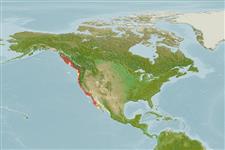分類 / Names
俗名 | 同種異名 | Catalog of Fishes(屬, 種) | ITIS | CoL | WoRMS | Cloffa
Teleostei >
Ovalentaria/misc (Various families in series Ovalentaria)
鱸形目 (Various families in series Ovalentaria) >
Embiotocidae (Surfperches)
海鯽科 (Surfperches)
Etymology: Cymatogaster: Greek, kyma,-atos = wave, swelling, bump + Greek, gaster = stomach (Ref. 45335); aggregata: Cymatogater foetus belly - alluding to the fact that it is a live bearer; aggregata crowded together (Ref. 4930).
Environment: milieu / climate zone / depth range / distribution range
生態學
海洋; 半鹹淡水 居於水底的; 非遷移的; 深度上下限 1 - 146 m (Ref. 2850). 亞熱帶的; 57°N - 21°N, 137°W - 105°W
Eastern Pacific: Wrangell, southeastern Alaska to Bahia San Quintin, northern Baja California, Mexico.
東太平洋: Wrangell ,阿拉斯加州東南方到 Bahia 桑河 Quintin ,墨西哥的下加利福尼亞北部。
大小 / 重量 / 年齡
Maturity: Lm ? range ? - ? cm
Max length : 20.3 cm TL 雄魚/尚未辨別雌雄; (Ref. 27547); common length : 11.5 cm TL 雄魚/尚未辨別雌雄; (Ref. 12193); 最大年齡: 9 年 (Ref. 56049)
背棘 (總數) : 8 - 11; 背的軟條 (總數) : 19 - 22; 臀棘: 3; 臀鰭軟條: 22 - 25; 脊椎骨: 33 - 37. Distinguished by the rather deep, compressed body, the large scales, and the three spines in the anal fin (Ref. 27547). Lateral line slightly arched, complete (Ref. 27547). Generally silvery, with back dusky to greenish; middle of sides toward head are scales with groups of fine black dots on them, forming about eight longitudinal stripes; the stripes are often interrupted, especially in females, by three pale yellow, vertical bands; paired fins colorless; dorsal and caudal fins plain or dusky; anal fin usually colorless, sometimes with a yellow blotch toward the front (Ref. 27547). Breeding males may be almost solid black and develop fleshy lobes on both sides of anal fin (Ref. 27547).
在臀鰭中區別的特徵為相當深又扁長形的身體,大的鱗片與這三個棘了。 (參考文獻 27547) 側線些微弓形, 完成.(參考文獻 27547) 通常銀色的, 藉由暗色的背面到呈綠色的; 對於頭部的側邊中央是在他們上鱗片有群體的細黑色的點, 形成大約八條縱向的斑紋; 斑紋時常被中斷, 尤其在雌性中, 三條白黃色又垂直的條紋; 偶鰭無色的; 背鰭與尾鰭鰭平原或暗色的; 臀鰭通常無色的, 有時有一個黃色的斑塊朝向前面.(參考文獻 27547) 繁殖期的雄性可能是幾乎純黑色而且在臀鰭的兩邊上發育肉質的葉.(參考文獻 27547)
Usually in shallow water, around eelgrass beds, piers and pilings and commonly found in bays and quiet back waters (Ref. 2850). Also in calm areas of exposed coast (Ref. 2850). Enter estuaries and brackish waters (Ref. 114138) [noted from freshwaters in Ref. 2850, but it is unlikely or rarely]. Found in loose schools or aggregations (Ref. 2850, Ref. 114138). Young feed mainly on copepods, while adults eat various small crustaceans, mollusks, and algae (Ref. 27547). Viviparous, female carries the developing young (Ref. 205). Exhibit seasonal onshore-offshore movements (Ref. 27547).
通常在淺水區, 鰻草床,碼頭與樁材的周圍而且普遍發現於海灣與安靜的背面水域.(參考文獻 2850) 也在裸露海岸的平靜區域中.(參考文獻 2850) 進入半鹹淡水與淡水。 (參考文獻 2850) 發現於鬆散的魚群或群集了。 (參考文獻 2850) 幼魚主要吃橈腳類的動物, 雖然成魚吃各種不同的小型甲殼動物,軟體動物與藻類。 (參考文獻 27547) 顯示季節性的向陸及離陸的運動。 (參考文獻 27547)
Viviparous. Mating is preceded by courtship. The male moves slowly toward the female, who retreats. Her flight stimulates pursuit by up to 10 males. During the pursuit, males attempt to bring their anal regions in contact with that of the female. One male heads off the female, urging her away from the group of males and also driving them away. The female is conducted to the shelter of a rock or other object, where the courtship dance begins. In this dance, the male, with dorsal fin fully erect, swims by means of his pectoral fin in a figure eight pattern over the female, udulating in both the horizontal and vertical planes. The male then stops, faces the female head to head, quivers, then moves his jaws and undulates his dorsal fin. He then moves beside the female, facing in the same direction, and repeats the movements. Finally, the male tilts on his side, the female tilts slightly away from hin, and the anal regions are brought in contact with each other. Copulation lasts less than a second. Gestation takes five to six months. Bears 3 to 36 young. Female carries the developing young (Ref. 205). Males are mature and ripe at birth. Juvenile females are mated soon after being born (Ref. 27547).東太平洋: Wrangell ,阿拉斯加州東南方到 Bahia 桑河 Quintin ,墨西哥的下加利福尼亞北部。
Eschmeyer, W.N., E.S. Herald and H. Hammann, 1983. A field guide to Pacific coast fishes of North America. Boston (MA, USA): Houghton Mifflin Company. xii+336 p. (Ref. 2850)
人類使用
漁業: 低經濟; 游釣魚種: 是的; 誘餌: occasionally
工具
特別的報告
下載 XML
網路資源
Estimates based on models
Preferred temperature (Ref.
123201): 8 - 12.1, mean 9.7 °C (based on 100 cells).
Phylogenetic diversity index (Ref.
82804): PD
50 = 1.0000 [Uniqueness, from 0.5 = low to 2.0 = high].
Bayesian length-weight: a=0.01905 (0.00831 - 0.04372), b=2.97 (2.77 - 3.17), in cm total length, based on LWR estimates for this (Sub)family-body shape (Ref.
93245).
營養階層 (Ref.
69278): 3.0 ±0.31 se; based on food items.
回復力 (Ref.
120179): 中等的, 族群倍增時間最少 1.4 - 4.4年 (tm=1; tmax=9; Fec=3-78).
Fishing Vulnerability (Ref.
59153): Low vulnerability (10 of 100).
Nutrients (Ref.
124155): Calcium = 138 [81, 257] mg/100g; Iron = 1.39 [0.71, 2.41] mg/100g; Protein = 18.6 [17.6, 19.7] %; Omega3 = 0.345 [0.203, 0.581] g/100g; Selenium = 29 [15, 58] μg/100g; VitaminA = 7.59 [2.44, 25.34] μg/100g; Zinc = 1.03 [0.72, 1.51] mg/100g (wet weight);
